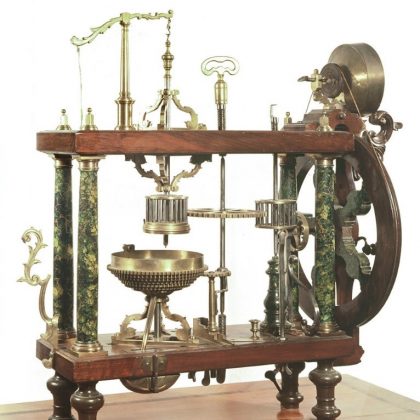Empire in the Soil: Superphosphate and the British and French Imperial Manufacture, 1914-1937
The history of European imperial agriculture has often been told through the lens of technological innovation, such as the development of the agricultural automotive industry or the application of advanced irrigation systems. But within this history there has remained one product that has been overlooked by historians: superphosphate (SSP). While its usage as a chemical fertiliser in modern agriculture has been surpassed by newer, more concentrated alternatives such as triple superphosphate (TSP), the imperial manufacture of superphosphate by the British and French empires in the early twentieth century marked a critical point in the history of European imperial agriculture.
Superphosphate production in the late nineteenth century had been the world’s first venture into the manufacture of chemical fertilisers; by the First World War, superphosphate was the main fertiliser in a class known as “artificial manures”. The growing commercial trade in, and consumption of, superphosphate was significant to different types of agricultural systems, (i.e., food production), undergoing accelerated forms of commodity production, or so-called “multiple agrarian capitalisms”. Made from the amalgamation of phosphate rock with sulphuric acid to the ratio of 1:1, superphosphate provided an invaluable source of phosphorous, an essential nutrient for positive root development, plant growth, and overall plant health, to the soil and thereby safeguarded long-term fertility and production. The exponential increase in superphosphate production thus responded to, and anticipated growing markets for, chemical fertiliser.
By the second decade of the twentieth century, perhaps nowhere had this market become as great as on the monoculture plantations of European colonies. In the twenty-first century, few words in agriculture have such an inherently negative ring as the term “monoculture”. With soil exhaustion and erosion, weeds and pests, and uneven fluctuations in temperature and precipitation threatening ecological collapse, access to chemical fertilisers was an urgent matter for most, if not all, European imperial powers.
Phosphate rock – a key source of phosphorous – was not a rare natural resource by way of distribution. Deposits could be found in mainland Europe as well as in the small oceanic territories of the Pacific Ocean. But for all its geographical reach, deposits were concentrated in only a few locations. Labelled the “phosphate rock frontier regions”, these locations included the American South, North Africa, and the South Pacific. Here, phosphate rock deposits were of sedimentary marine origin, high in phosphorous concentration, and easy to exploit. Most importantly, these sites were European colonies.
By the outbreak of the First World War, almost all major European imperial powers were securing access to these concentrated deposits. While all experienced some form of social, economic, and/or political gain, France underwent a remarkable transformation as the North African frontier region developed. Already the largest superphosphate producer in Europe at the turn of the twentieth century through the importation of phosphate rock from the United States, with access to concentrated deposits in Algeria, Tunisia, and Morocco, by 1913, France had produced an export boom that welcomed in the “golden age of French metropolitan phosphate production”; a period that only began to wane in the early 1930s.
Britain experienced similar success, although a few years later. As with France, the independent production and manufacture of superphosphate had been a continuous point of debate for British colonial officials. Concentrated phosphate rock deposits were present in extensive tracts across the Nile Valley and upon the Red Sea Coast of the British Protectorate of Egypt but were not exploited to the extent of French North Africa due to the necessity for a cheap supply of sulphuric acid; Egypt was too far from Greece and Italy, the centres of European sulphuric acid production. This changed in 1916 when the mineral known as pyrite – an iron sulphide capable of producing sulphuric acid – was discovered in several parts of Cyprus. Containing 4 million tons on average in each mine, the quantity of pyrite in Cyprus was enough for the long-term manufacture of superphosphate. By 1937, Britain was a leading power in the manufacture of superphosphate alongside France.
It is hard to overstate the extent to which the British and French imperial manufacture of superphosphate transformed imperial agriculture, particularly monoculture, in the early twentieth century. As mentioned, monocultures exhaust soils, breed plant diseases, and produce horrendous weed and pest problems. The intensive use of soil in the large-scale imperial production of agricultural commodities thus required some method to replace nutrients lost. Superphosphate did just that. Positioned as a vehicle for regenerating and regulating soil health and productivity, superphosphate offered European imperial powers opportunities to continue large-scale monocrop production despite ecological limits and restraints. The independent and imperial manufacture of superphosphate by the British and French empires allowed imperial officials to transform plantation environments from closed-loop circuits, (i.e., using local resources such as animal waste), to global input intensive systems. This transition, often referred to as the transition from organic to inorganic farming, marked the first time chemical fertilisers were integrated into the fundamentals of imperial agricultural production on a large and commercial scale. For all the technological innovations associated with the history of European imperial agriculture, perhaps none have been as transformative as the British and French imperial manufacture of superphosphate.
Rosie Charles is a History PhD student at the University of Warwick.
If you’re a postgraduate student or ECR researching any aspect of post-1914 European history (including the UK and Europe’s overseas empires), we’d love to hear from you. To submit a blog idea, or for more information about New Voices, please email cehnewvoices@gmail.com
Image Credit: World map of the principal phosphate rock deposits by World War II (A.N Gray, Phosphates and Superphosphate [London: International Superphosphate Manufacturer’s Association, 1944])






